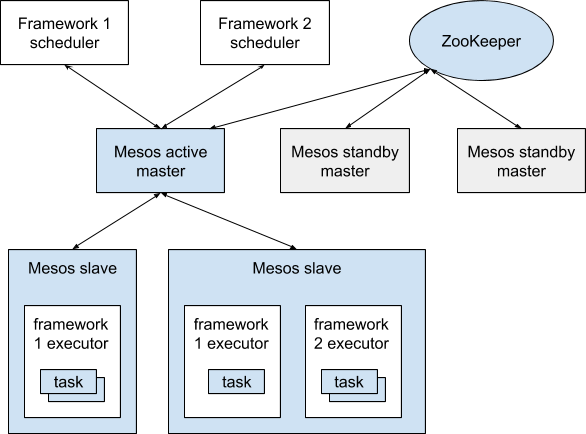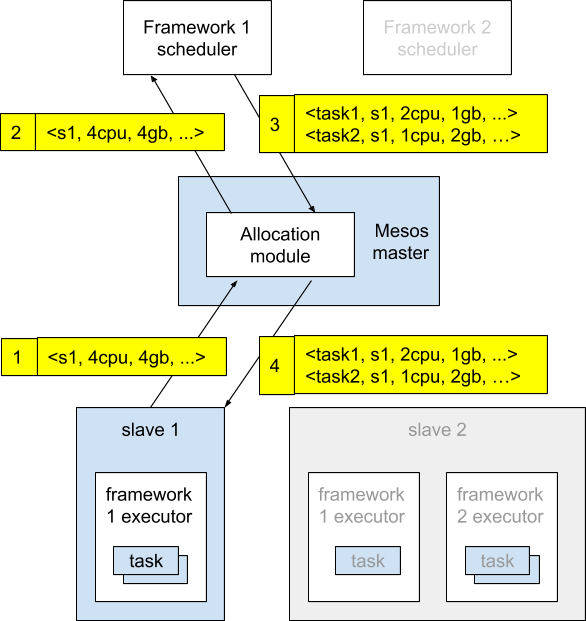Mesos
Mesos was originally launched by UC Berkeley’s AMPLab in 2009. It is licensed under Apache and now operated by Mesosphere, Inc.
Mesos can abstract and schedule the resources of the entire data center (including CPU, memory, storage, network, etc.). This allows multiple applications to run in a cluster at the same time without needing to care about the physical distribution of resources.
Mesos has many compelling features, including:
- Support for large scale scenarios with tens of thousands of nodes (adopted by Apple, Twitter, eBay, etc.)
- Support for multiple application frameworks, including Marathon, Singularity, Aurora, etc.
- High Availability (relies on ZooKeeper)
- Support for Docker, LXC and other container techniques
- Providing APIs for several popular languages, including Python, Java, C++, etc.
- A simple and easy-to-use WebUI
Architecture
It is important to notice that Mesos itself is only a resource scheduling framework. It is not a complete application management platform, so Mesos can’t work only on its own. However, based on Mesos, it is relatively easy to provide distributed operation capabilities for various application management frameworks or middleware platforms. Multiple frameworks can also run in a single Mesos cluster at the same time, improving overall resource utilization efficiency.

Components
Mesos consists of a master process that manages agent daemons running on each cluster node, and frameworks that run tasks on these agents.
Mesos master
The master sees the global information, and is responsible for resource scheduling and logical control between different frameworks. The frameworks need to be registered to master in order to be used. It uses Zookeeper to achieve HA.
Mesos agent
The agent is responsible for reporting the resource status (idle resources, running status, etc.) on the agent node to master, and is responsible for isolating the local resources to perform the specific tasks assigned by master.
Frameworks
Each framework consists of two components: a scheduler that registers with the master to be offered resources, and an executor process that is launched on agent nodes to run the framework’s tasks.
Resource scheduling
To support the sophisticated schedulers of today’s frameworks, Mesos introduces a distributed two-level scheduling mechanism called resource offers.
Each resource offer is a list of free resources (for example, <1Core CPU, 2GB RAM>) on multiple agents. While the master decides how many resources to offer to each framework according to an organizational policy, the frameworks’ schedulers select which of the offered resources to use. When a framework accepts offered resources, it passes Mesos a description of the tasks it wants to launch on them.

The figure shows an example of how resource scheduling works:
- Agent 1 reports to the master that it has 4 CPUs and 4 GB of memory free. The master then invokes the allocation policy module, which tells it that framework 1 should be offered all available resources.
- The master sends a resource offer describing what is available on agent 1 to framework 1.
- The framework’s scheduler replies to the master with information about two tasks to run on the agent, using <2 CPUs, 1 GB RAM> for the first task, and <1 CPUs, 2 GB RAM> for the second task.
- Finally, the master sends the tasks to the agent, which allocates appropriate resources to the framework’s executor, which in turn launches the two tasks (depicted with dotted-line borders in the figure). Because 1 CPU and 1 GB of RAM are still unallocated, the allocation module may now offer them to framework 2.
To maintain a thin interface and enable frameworks to evolve independently, Mesos does not require frameworks to specify their resource requirements or constraints. Instead, Mesos gives frameworks the ability to reject offers. A framework can reject resources that do not satisfy its constraints in order to wait for ones that do. Thus, the rejection mechanism enables frameworks to support arbitrarily complex resource constraints while keeping Mesos simple and scalable.